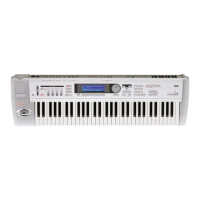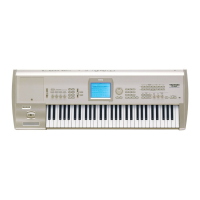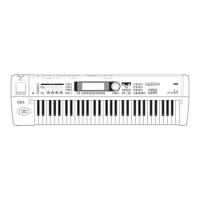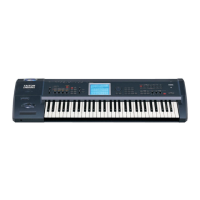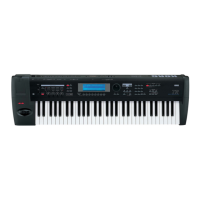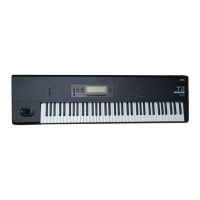11. When you want to…
71
STEP 3
Edit parameters via MIDI
You can edit the parameters of the TRINITY using Parameter Change exclusive messages.
If Global mode Enable Exclusive is checked, parameter change messages will be transmitted when
you edit in Combination Edit mode or Program Edit mode, or when you use the performance edi-
tor.
Parameter Change messages contain the number of the parameter, and the current value. Another
TRINITY series instrument that receives these messages (if it is receiving exclusive data) will per-
form the corresponding edit on its own data.
Since edits are performed on the data in the edit buffer, they are not stored into internal memory
unless you write the data. Data can be written in the usual way by either using the [REC/WRITE]
key or a writing command, or by using a Write Request exclusive message.
If the Global mode Enable Exclusive setting is checked, editing a drumkit in Global mode P5 will
cause Drum Parameter Change messages to be transmitted. These are essentially the same as
Parameter Change messages, but the changes will be saved in internal memory without the need
for the Write operation.
Use the TRINITY’s sequencer to control connected MIDI
equipment
Musical data recorded on the TRINITY’s sequencer can play the internal tone generator, and can
in addition play external tone generators or be recorded on external sequencers.
Tracks whose Track Status is set to EXT or BOTH will transmit the data recorded on them via
MIDI. Of this data, external tone generators will receive (and play) the data whose channels match
their own MIDI channel setting.
You can also control an external sequencer (start/stop and tempo, etc.) from the TRINITY.
When an external sequencer set to operate on an external clock receives this control data, it will
playback its recorded data.
Use the TRINITY as a multi-timbral tone generator played
by a connected sequencer
MIDI messages transmitted from an external sequencer can play the TRINITY as a multi-timbral
tone generator.
Tracks whose Track Status is INT or BOTH will sound in response to incoming MIDI data whose
channel matches their own. This means that musical data containing multiple parts each on their
own MIDI channel can play the TRINITY as a multi-timbral tone generator.
An external sequencer can also control the TRINITY’s internal sequencer (start/stop and tempo,
etc.).
When the Global mode MIDI Clock setting is External, the internal tempo setting will be ignored,
and the recorded sequence data of the internal sequencer will playback in synchronization with
control messages received from outside.
Tune the TRINITY
Use the Global mode Master Tune setting.
1 Press the [GLOBAL] key to enter Global mode.
2 Press the [P1] key.
3 Select Master Tune.
4 Use the VALUE controllers to set the value.
The setting is made in units of a cent, and the Hz setting (the frequency of A4) will also be dis-
played.
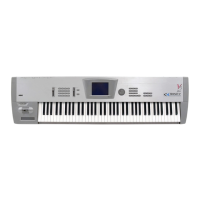
